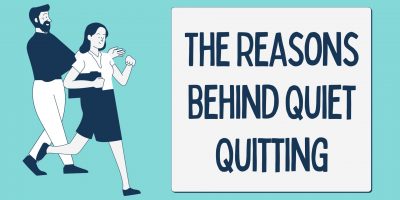
How Workplace Design affects Productivity?
How does workplace design affect productivity? Can the corporate workplace be a place that offers both meaning and efficiency?

What is “quiet quitting”, and why is it a hot topic right now?
Is it just another name for work-to-rule or a complete re-evaluation of our social norms and a rejection of hustle culture?
Countless articles have named this trend “the new epidemic,” and while some view this viral phenomenon as a positive development, many were quick to criticize it – causing a big stir between various polarizing opinions.
This article explores the reasons for quiet quitting and what the latest labor narrative means for HR teams and employers.
Following the uproar of the Great Resignation, today, a new trend has emerged to describe a widespread alternative to resigning: “quiet quitting.”
Driven by similar underlying factors as traditional resignations, quiet quitting refers to the act of becoming less physically invested in one’s duties and work. In other words, quiet quitters continue to fulfill their core tasks but opt out of tasks beyond their assigned duties.
Essentially, the meaning of quiet quitting has, in fact, very little to do with quitting.
It’s more of a philosophy for “acting your wage” and employees making a conscious effort to scale back their output at work. People are tired of the expectation that workers must go above and beyond the job requirements and, in return, receive low pay and a poor quality of life.

At first sight, this trend may not seem problematic.
After all, employees aren’t disengaging from their primary responsibilities – they’re just refusing to do additional tasks. However, a workforce willing to go beyond the call of duty gives many companies their main competitive advantage.
In practice, most office jobs cannot be fully defined in a formal job description or contract, so organizations expect employees to step up and fulfill extra demands as needed.
For employees, this increased role ambiguity translates to more stress, burnout, and lower job satisfaction.
As a result, employees are less willing to engage in activities known as organizational citizenship behaviors (OCB). Citizenship behaviors are positive activities beyond the formal scope of the job, such as staying late, attending a non-mandatory meeting, and helping a coworker with a project.
Employers were quick to criticize and react negatively to the quiet quitting trend.
While losing employees is difficult, especially in peak times of labor shortages, employers argue that having workers not quit is even worse as it puts an extra burden on others.
Disengagement is contagious, spreading quickly across all levels of business.
Ultimately, employers can’t afford to keep a disengaged workforce on their payroll without risking bankruptcy. However, employers may need to look in the mirror to find the culprit of disengagement.
Poor organizational leadership is often responsible for creating employee disengagement.
In fact, over 33% of employees say their disengagement is caused by a lack of confidence in their senior leadership, and another 38% feel disengaged due to factors including a lack of recognition, teamwork, respect, or freedom.
Think about it: how many employees have felt replaceable?
In a tight labor market, the organizational mindset that employees are expendable has suddenly shifted. Workers now have more bargaining power and aren’t afraid to call out these damaging imbalances of influence.
According to one Gallup report, 79% of the global workforce is disengaged, so it’s no surprise that employees are demanding a firmer work-life balance. Another newly-released report from Gallup shows that over 50% of U.S. workers admit to quiet quitting. Disengagement and quiet quitting are not new concepts, and the idea of work-to-rule has been around for a while.
Other employee engagement trends and similar phenomena which relate to the quality of the employee experience are:
Dismissing quiet quitting as only a momentary trend risks further disengagement, but more importantly, it overlooks the genuine reasons workers are stepping back from their roles.

Regardless of which buzzy phrase is being used, companies and HR teams must not ignore the real reason why these terms were coined.
The message is loud and clear: burnout and stress levels have increased dramatically since the COVID-19 pandemic began. In January 2022, the American Psychological Association (APA) reported that burnout and stress levels are at an all-time high across all professions.
The pandemic pushed many employees into a state of burnout, and many are tired of the daily grind and choose only to do what they’re required to do. The switch to remote work culture contributed to many employees working longer hours, taking lunch breaks in front of a computer, and experiencing a lack of boundary between work and home life.
As the effects of the pandemic are still lingering and questionable ethics in the workplace are still present, the stressors have only become more persistent and indefinite. Therefore, it is no surprise that employees no longer see their workplace as a place to prosper and instead feel disengaged and unmotivated.
So, are burned-out employees quiet quitting their jobs?
While it may seem that many employees are moving towards the quiet quitting trend, what they’re actually doing is saying “no” to burnout. In reality, many employees simply re-establish boundaries and refuse extra tasks outside their work hours.
Interestingly, the increase in burnout is noticeably higher among the younger generation of workers.
As much as 53% of millennials in the workplace already felt burnt out pre-pandemic, and this figure only jumped to 59% in 2021.
In fact, many studies show that burnout is more likely to impact employees between the ages of 18 and 34, so it’s only to be expected that Gen-Z started quiet quitting.
While the quiet quitting trend is gathering momentum among Gen Z and millennials, findings suggest that the desire to do the bare minimum is a widespread problem. In fact, this desire is consistent across gender, race, and political views, and it’s not isolated to one demographic group.
As Gen Z and other younger employees enter the workforce, they like to throw out the old rulebook and challenge the way things are done in favor of a better future.
Hence, we’re seeing a shift from hustle culture to positive values like meaningful work, dignity in the workplace, and satisfaction outside work.
Looking back on the past couple of years, they can only be described as a perma-crisis – an extended period of instability and insecurity.
The “soft quitting” movement is simply a reflection of people’s changed relationship with their work driven by these recent events.
From employers’ lackluster response to the pandemic, the move to remote work, and now the demand to return back to the office, as well as the employee-friendly job market, all created a perfect storm that made people rethink what role they want their occupation to play in their lives.
One crucial element of the “Great Resignation” is people seeking new career paths more aligned with their values.
However, with the cost-of-living crisis and political upheaval, this last year has been awful for many people. As the economic outlook worsens, handing in a resignation becomes less feasible for many people, thus quiet quitting is becoming increasingly common.
Maybe quiet quitting is simply an evolution of the “Great Resignation,” or maybe people feel foolish for going the extra mile pre-pandemic just to be laid off in the end.
The social contract indicates that overperforming can come at a cost for employees, but there are also benefits, such as increased social capital, career success, and improved financial wellness. The quiet quitting trend suggests that employees feel this exchange is unbalanced or no longer attainable. Employers are demanding more effort, and in return, employees have to deal with low pay, inadequate staffing, and unreasonable demands.
Workers are correct in “acting their wage,” and generally, this trend is viewed as a positive development – but not by all.

Since social media popularized this term, there have been countless takes on it.
Quiet quitting’s advocates argue that it is a way to safeguard mental health and avoid burnout. Other critics say that the quitting mindset promotes laziness and hurts performance.
But even more, concerning is the fact that employees may be unknowingly worsening DEI initiatives in the workplace.
Aside from this trend being labeled as too passive-aggressive, critics point out that workers can’t accomplish what they want since they don’t speak up, and instead, it only places more of a burden on coworkers.
The people who tend to experience the highest levels of burnout are low-income earners, women and minorities, all of which likely can’t afford to “quiet quit.” In addition, these minority groups may have to face greater obstacles when it comes to advancing in their careers.
One study showed that managers underestimate women’s potential more than men’s.
In comparison to their male colleagues, women are 14% less likely to be promoted.
Other reports point out that Black employees tend to receive more scrutiny from managers than their white coworkers and feel they need to work twice as hard for a promotion. For these reasons, it’s easy to see how the quiet quitting trend could exacerbate these inequalities in the workplace.
Seemingly every generation has its own anti-work philosophies, and many managers and leaders take issue with them.
In the backlash against quiet quitting, many professionals were right to call out reasons why this trend is damaging not only to corporations but other employees.

The good news is that employers can take certain steps to address the root cause of employee dissatisfaction.
The first step is acknowledging that some workers may not be happy at work and starting a dialogue on what can be improved. When companies listen, understand, and invest in their workers, employees can feel supported and thrive. This means executive leadership should make time to connect with employees, but also encourage and incentivize middle management to keep track of how their employees are feeling.
By gathering quantitative and qualitative data about employee engagement, employers can improve the work culture and get insights into the employee experience. HR analytics tools such as performance management software, employee rewards platforms, and productivity tracking tools can help point out any discontent in individual employees.
In addition, it’s important to redefine job tasks and employees’ core duties. As it’s only natural that employees’ job duties shift over time, it’s vital to recalibrate them to accurately reflect what work is essential to their role and what qualifies as extra.
Finally, leaders should be careful and avoid creating an always-on culture, as it will inevitably lead to employee burnout. Tackling employees’ quiet quitting isn’t about forcing them to be more productive – it’s about listening to their concerns and addressing them.
Quiet quitting sparked a passionate commentary around the importance of drawing personal boundaries at work.
Employers can take this opportunity to rethink incentives, learn how to keep their employees engaged, and reinforce a healthy work-life balance for all employees.
On the other hand, employees need to be aware that inaction may only hurt their careers in the long run.
Browse our curated list of vendors to find the best solution for your needs.
Subscribe to our newsletter for the latest trends, expert tips, and workplace insights!

How does workplace design affect productivity? Can the corporate workplace be a place that offers both meaning and efficiency?

Beyond holiday festivities and annual performances, here’s why December’s focus should be about celebrating human rights in the workplace.

What does the latest labor narrative mean for HR teams and employers?

In the face of a slowdown in hiring, sweeping policy changes, economic uncertainty, and an increase in ghost jobs, securing employment seems more challenging than ever. However, there may still be a silver lining.
Used by most of the top employee benefits consultants in the US, Shortlister is where you can find, research and select HR and benefits vendors for your clients.
Shortlister helps you reach your ideal prospects. Claim your free account to control your message and receive employer, consultant and health plan leads.